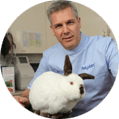Expert nutritionist Bianca Major discusses the advantages and disadvantages of feeding your dog a raw food diet.
Domestic dogs evolved from the grey wolf thousands of years ago and there has been very minimal evolution within their gastrointestinal tracts since then. While domestic dogs can digest some starches, such as rice and cooked potatoes, many believe that this small evolutionary change is due to dogs adapting to what they’re being fed rather than them eating a more ancestral-type diet, similar to that eaten by wolves.
Dogs are known as facultative carnivores. As such, they have very sharp teeth for cutting and a scissor motion to their jaw, which is ideal for clamping and holding down meat. The majority of a dog’s diet should be meat-based, with a small amount of plant matter, as well.
Moreover, dogs have a very short gastrointestinal tract (it’s around seven feet long), which is designed to process food quickly compared with a herbivore.
Raw diet for dogs
Raw dog and puppy foods on the market today are very different from those of ten years ago. The commercialisation of raw dog foods has made them much safer. Before raw dog food is sold to the public, it is frozen down to very cold temperatures to kill off bacteria.
In addition, dogs have a naturally high, acidic pH in their stomach, which is able to efficiently break down food and small bone and kill bacteria. Homemade raw food diets, however, should be treated with caution since these can expose dogs to salmonella and other bacteria while also being improperly balanced from a nutritional perspective.
Are bones safe for dogs?
Bones can be incredibly dangerous for dogs if they're cooked. But when raw, a bone’s integral structure is soft and spongy. The cooking is what makes bone brittle and can cause splinters in the digestive system. Raw, edible bones can be very good for dogs’ teeth while also being rich in fibre, vitamins and minerals. As a result, they form an essential part of a dog’s raw food diet.
Recreational bones are weight-bearing bones like beef knuckles. These are a non-dietary essential, but chewing them provides great mental stimulation to dogs. Bones have a high value to dogs. To avoid disputes, it is advisable to separate dogs in a multi-dog household when feeding recreational bones.
Complete raw dog food
It’s always better to go for a complete and balanced raw dog food as these foods usually contain the essential nutrients that dogs need. Look for a registered manufacturer that is a member of UK Pet Food. It’s also possible to get complementary food to make at home.
Additionally, there are HPP (high-pressure pasteurisation) raw foods starting to enter the market. These are great for dogs that are immunocompromised, but whose owners want them to stay on a raw food diet. If you’re not sure which raw dog food is best for your dog, consult your vet or pet nutritionist.
Is raw dog food safe for humans?
Raw dog food can be very safe for humans if handled correctly. Be sure to defrost it in the fridge using a leak-proof container or packaging. It’s also essential to make sure you use separate utensils (that you wash carefully afterwards) and wash your hands. Be sure to feed the juice and blood from the defrosted meat to your dog since this can contain a lot of essential nutrients. Dispose of uneaten food carefully.
Whether your dog licks you after it has been eating raw food should be of as much concern as if it licks you at any other time. Dogs eat from bins and lick and sniff everything they find. If the raw food has been handled correctly, you should be at no greater risk than you would from a normal dog lick.
Benefits of raw dog food
There is increasing research emerging about the effect of raw diets on overall canine health. Because raw food is often minimally processed, the nutrients are more biologically available for the dog to use and this can help with things like reducing stool size (and, luckily for the owners, smell).
There have been other reported benefits such as improved skin, coat and dental health. Most kibble diets contain at least 30% starch, which breaks down into sugars. Kibble contains roughly 8% to 12% moisture compared with 70% to 80% in a raw food diet. The huge increase in moisture in a raw diet, compared with a kibble diet, is thought to assist in keeping the body naturally hydrated, supporting the efficient functioning of the dog’s organs.
Additionally, you don’t tend to see overweight raw food-fed dogs. Raw food helps regulate insulin levels in the body and results in fewer mood changes so dogs tend to be calmer on a raw food diet.
Do dogs like raw food?
Dogs have great instincts and are able to detect more bioavailable protein sources. If you're out on a walk and there's a dead carcass, most dogs are straight into it. Some studies have even shown that when dogs are offered fat, protein and carbohydrates, they choose fat and protein.
Is raw dog food sustainable?
We’re all mindful of the environmental impact associated with meat production, but raw dog food uses waste from the mainstream human meat industry. It includes products like tripe and cuts that aren’t sold in supermarkets and complements the meat industry by minimising waste and ensuring that the entirety of a slaughtered animal is used.
Switching your dog to a raw food diet
Suddenly switching to any diet is a shock to a dog’s system, so doing it slowly and steadily is best. When switching your dog’s diet, add in a probiotic (to help prevent gastric upset) and switch gradually, over seven to ten days. Most dogs manage on a raw food diet without problems, but it’s always good to consult a vet with raw food experience if you have any issues.
